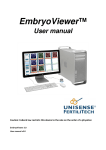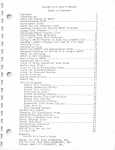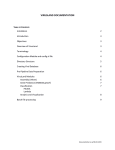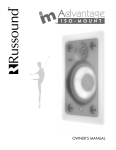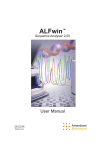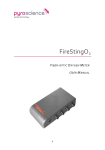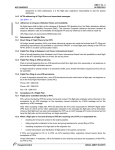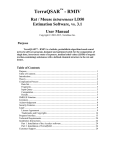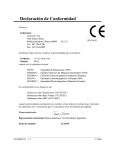Download EmbryoScope™ Embryo Monitoring System
Transcript
EmbryoScope™ Embryo Monitoring System - Version D User Manual Version 2.10 Caution: Federal law restricts this device to the sale by or on the order of a physician or a practitioner trained in its use. Unisense FertiliTech A/S EmbryoScope™ Embryo Monitoring System - Version D User Manual 2010 version 2.10 Indications for Use EmbryoScopeTM To provide an environment with controlled temperature, CO2 (and other gases) for the development of embryos. This model has an integrated inverted microscope and imaging system for embryo viewing. Device use is limited to three days (72 hr) covering the time from post-fertilization to day 3 of development. EmbryoSlideTM Preparing, storing, and transferring human embryos. To be used only with the EmbryoScope device. The procedures described in this manual concern a particular Medical Device installed by Unisense FertiliTech A/S personnel at a designated location. The EmbryoScope™ Version D (in the following called EmbryoScope™ D) MUST be operated by trained personnel according to instructions contained in this user manual. This product fulfills the requirements of the UL 60601-1 and IEC 60601-1 standards; class I, type B equivalent. The device is suitable for continuous operation. Medical Device Directive: The EmbryoScope™ D and related accessories conform to the requirements of the EU Council directive 93/42/EEC concerning medical devices, classified as class IIa. Conforms to ANSI/UL Std.60601-1 Certified to CAN/CSA Std. C22.2 No.601.1 Unisense FertiliTech A/S employees will undertake device setup and training of personnel involved in the routine operation of the device. Unisense FertiliTech A/S will perform scheduled maintenance and recalibration checks according to a service plan to ensure continued safe and efficient operation. The end user is strongly encouraged to follow the service plan carefully to ensure error free operation of the equipment. 2 Unisense FertiliTech A/S EmbryoScope™ Embryo Monitoring System - Version D User Manual 2010 version 2.10 IMPORTANT Safety Instructions The following safety instructions shall ensure safe and correct use of the EmbryoScope™ D and prevent injury to the operator and other personnel as well as damage to property. You must agree to read and understand this user manual and observe the safety instructions to be allowed to operate the EmbryoScope™. Restrictions on Use The EmbryoScope™ D may only be used by qualified personnel trained by Unisense FertiliTech A/S employees. The EmbryoScope™ D may only be used with sterile disposable EmbryoSlides™ produced and sold by Unisense FertiliTech A/S. The EmbryoSlides™ may not be reused. EmbryoSlides™ and EmbryoSlide™ Lids are sterile. All handling of EmbryoSlides™ and EmbryoSlide™ Lids should take place in a sterile workbench; preferably a laminar flow hood with HEPA filtered sterile airstream. The EmbryoSlides™ MUST be covered with sterile lids before insertion into the EmbryoScope™ D The device must always be connected to an un-interrupted power supply (UPS) to ensure stable operating conditions in case of power failure. Users should contact Unisense FertiliTech A/S immediately to report any incident and/or injury to a patient, operator, or maintenance employee that occurred as a result of operating the EmbryoScope™ D. Should an accident occur while using the EmbryoScope™, stop using the device until it has been checked by an authorized service agent. Warning The device may only be operated by trained personnel. The device includes moving parts with safety stops. Do not try to block safety sensors to insert a finger or a hand into the device while it is turned on. This is dangerous and may cause injury. Do not touch any moving parts when power is ON or during operation. This may cause injury. Mishandling or misuse of the EmbryoScope™ may result in serious injury to the user. Installation and Maintenance Installation, inspection, adjustment and wiring of the EmbryoScope™ D can only be carried out by a certified Unisense FertiliTech A/S employee. The EmbryoScope™ shall remain at the location where it was installed by a Unisense FertiliTech A/S employee and may only be moved by Unisense FertiliTech A/S personnel or upon explicit authorization in writing. 3 Unisense FertiliTech A/S EmbryoScope™ Embryo Monitoring System - Version D User Manual 2010 version 2.10 Contents Version 2.10 ................................................................................................................................. 1 Indications for Use ...................................................................................................................... 2 EmbryoScopeTM .......................................................................................................................... 2 IMPORTANT Safety Instructions ............................................................................................ 3 General Overview ....................................................................................................................... 5 Features ........................................................................................................................................ 5 Blastomere Activity ..................................................................................................................... 5 Technical Specifications .............................................................................................................. 6 Device Setup ................................................................................................................................ 7 Instructions and Training of Personnel ........................................................................................ 7 Device Installation ....................................................................................................................... 7 Unpacking and Setup of EmbryoScope™ ................................................................................... 8 Connecting the EmbryoScope ...................................................................................................... 9 Device Startup ........................................................................................................................... 10 Change Temperature Setting of Incubator ................................................................................. 11 Change Gas Mixture Setting of Incubator ................................................................................. 11 Incubator Alarm Conditions....................................................................................................... 12 Computer Alarm Conditions ...................................................................................................... 12 Change and Inspect Incubation Values and Parameters ............................................................ 13 Lock Incubator Panel ................................................................................................................. 15 Measurement Setup .................................................................................................................. 15 Preparation of EmbryoSlides™............................................................................................... 21 Filling EmbryoSlides™ with media........................................................................................... 22 Loading embryos into EmbryoSlide™ wells ............................................................................. 23 Start Time-Lapse Imaging ....................................................................................................... 24 Add Slide.................................................................................................................................... 25 Finding Wells and Focal Planes for Image Acquisition ............................................................ 27 Runtime Feedback .................................................................................................................... 30 Slide Tabs ................................................................................................................................... 30 Live Inspection of and Refocusing on Embryos ........................................................................ 32 Temperature, CO2, O2 and Settings ........................................................................................... 35 Error Conditions ......................................................................................................................... 39 Pausing a Slide........................................................................................................................... 40 Periodic Validation Check by End User ................................................................................. 43 Starting Validation Checks ........................................................................................................ 43 Cleaning ..................................................................................................................................... 47 End a Running Slide ................................................................................................................. 49 Close Program or Computer ...................................................................................................... 49 Data Upload ............................................................................................................................... 50 Loading Data into the Viewer .................................................................................................... 50 Remove EmbryoSlides™ after Crash ..................................................................................... 50 Emergency Removal of Slides .................................................................................................. 50 In Case of Emergency ............................................................................................................... 52 Disposal of Waste ...................................................................................................................... 52 4 Unisense FertiliTech A/S EmbryoScope™ Embryo Monitoring System - Version D User Manual 2010 version 2.10 General Overview The EmbryoScope™ D is a tri-gas embryo incubator, which acquires a series of unattended measurements on individual embryos during their development. The measurements include: timelapse microscopy at multiple focal planes and logging of incubation conditions. Separate processing units control the incubation environment and the data acquisition to ensure safe and reliable operation. Features High resolution time-lapse image series at multiple focal planes. Automated detection and focusing of embryos in EmbryoSlides™. Incubation of up to 72 individual embryos™ in six sterile disposable polymer slides each with 12 embryos (e.g. up to six patients with 12 embryos each). Built-in tri-gas incubator, which controls temperature, carbon dioxide and oxygen levels. The device uses N2 and CO2 to maintain desired oxygen partial pressure and pH in a bicarbonate buffer system. Independent control units for data acquisition and control of incubation conditions. Air purified by HEPA and active carbon filters. Large load door facilitates cleaning and removal of EmbryoSlides™ in case of power failure. Blastomere Activity Image series are analyzed automatically in real time with proprietary software. Blastomere activity is a numerical parameter that reflects the amount of movement that has occurred between two consecutive frames in the time-lapse image series. The blastomere activity has NO DIAGNOSTIC USE, but can be used to aid users identify areas in the time series where events of interest may be occurring. No operator input is required and the output is available at any time during incubation. 5 Unisense FertiliTech A/S EmbryoScope™ Embryo Monitoring System - Version D User Manual 2010 version 2.10 Technical Specifications Incubator Capacity: 6 EmbryoSlide™ trays holding 12 embryos each, i.e. 72 embryos in total Temperature range: ambient temperature + 7°C to 45°C Temperature accuracy: during incubation +/- 0.1°C, between wells +/- 0.1°C CO2 range: 2 – 10% CO2 accuracy: +/- 0.2 % Oxygen range: 3 – 20% Oxygen accuracy: +/- 0.3 % Recovery time for CO2 and temperature after insert of EmbryoSlide™ < 5 min Alarms: Temperature CO2 concentration CO2 pressure O2 concentration N2 pressure Load door open more than 30 sec Air flow Recirculation >60 L/h (full purification of gas volume every 20 min) HEPA filter retains 99.97% particles > 0.3 µm Whatman Active Cap™ active carbon filter Embryo images 1280 x 1024 pixels monochrome CCD camera Leica custom-made high quality 20x, 0.40 LWD Hoffman Modulation contrast objective providing a resolution of 3 pixels per µm Illumination single red LED (635 nm duration < 0.1 sec per image) Total light exposure time < 50 sec per day per embryo Other Power supply: 110 – 240 VAC Frequency: 50-60 Hz Maximum power consumption: 250 VA Gas requirements: CO2 and N2 CO2 consumption: 5% CO2 < 1 L/h N2 consumption: 5% O2 < 10 L/h Dimensions: W x D x H (60 x 56 x 44) cm Weight: 60 kg 6 Unisense FertiliTech A/S EmbryoScope™ Embryo Monitoring System - Version D User Manual 2010 version 2.10 Device Setup Instructions and Training of Personnel The EmbryoScope™ D should only be operated by skilled and trained personnel. To obtain meaningful and reliable data from the EmbryoScope™ D it is essential that the operator knows how to load EmbryoSlides™ properly. Therefore it is necessary that the operator of the device is properly trained by Unisense FertiliTech A/S employees. The standard procedure for installation is Day 1: EmbryoScope™ D setup – complete check of all device functions overnight run with empty EmbryoSlides™– prepare EmbryoSlides™ for day 2 (full day, approx 8 hours). Day 2: Instructions – restart EmbryoScope™ D – load slides with mouse embryos – start experiment and discuss feedback during run – prepare slides for day 3 (full day, approx 8 hrs). Day 3: Trial experiment by trainee – evaluate overnight run – shut down EmbryoScope™ D – restart – start experiment with surplus discarded embryos from IVF clinic (full day, approx 4 hrs). Day 6: Evaluation and data transfer- discuss the two runs, pitfalls, artifacts and possible solutions – post processing of data (half day, approx 4 hours). A second visit by Unisense FertiliTech A/S employees should follow no later than three months after installation to re-calibrate the device and verify that it is operating properly. The second visit will usually last two full days. Subsequent visits are covered by the service plan, which usually involves at least a full day visit every six months. Device Installation The EmbryoScope™ D is installed and tested on site by certified Unisense FertiliTech A/S personnel. During installation extensive tests and calibration of the device are performed to ensure that the device is working correctly. The device should never be moved or disconnected by unqualified personnel. Installation requirements: Clean room with stable temperatures between 20 and 30°C Sturdy table with approximately 1.0 x 0.6 m bench space Uninterrupted power supply: 110 – 230 V, max 120 W with proper grounding Specification of attachment plug for connection to the alternate voltage: NEMA 5-15 (Hospital grade) – related current and voltage: 15 A, 125 V AC CO2 gas supply with pressure regulator capable of providing stable input of CO2 at 1 atm above ambient. N2 gas supply with pressure regulator capable of providing stable input of N2 at 1 atm above ambient (NOT required when incubating at ambient O2 concentration) Medical Electrical Equipment requires special precautions regarding EMC and has to be installed and put into service according to the EMC information provided. IMPORTANT NOTE: In case of room temperatures above specified limits the embryo chamber has no cooling function and will reach at least ambient temperature. 7 Unisense FertiliTech A/S EmbryoScope™ Embryo Monitoring System - Version D User Manual 2010 version 2.10 Device Parts Unpacking and Setup of EmbryoScope™ The recipient end user of the device should NOT unpack and install the device upon receipt. The EmbryoScope™ MUST be installed and tested on site by certified Unisense FertiliTech A/S personnel. The shipping conditions are: temperature: -10oC - +50oC, humidity: +30% - +85% - as indicated on the box label. The exterior of all shipping boxes should be inspected for signs of damage during transport. Should this be the case contact Unisense FertiliTech A/S immediately for further instruction: Unisense FertiliTech A/S Tel. +45 8944 9500 Fax. +45 8944 9549 E-mail. [email protected] If the boxes appear damaged, do NOT open them! Leave the EmbryoScope™ in the shipping boxes in a dry safe storage area until setup can be initiated by a Unisense FertiliTech A/S service technician. 8 Unisense FertiliTech A/S EmbryoScope™ Embryo Monitoring System - Version D User Manual 2010 version 2.10 Connecting the EmbryoScope ALL connectors and sockets on the back side of the instrument are ONLY for use by Unisense FertiliTech A/S in the installation procedure as described in the Service manual. Operators and end users should NEVER use or attach any tubing/wiring to the backside of the instrument. Rear view of the instrument. Attaching and securing CO2 and N2 supply through the appropriate and labeled inlets must be performed by Unisense FertiliTech A/S personnel. Connecting the EmbryoScope and the EmbryoViewer through an EtherNet cable require a special setup and must be made by Unisense FertiliTech A/S personnel. The instrument can and may NOT be connected directly to an internet gateway/ISP. Connections to a resident CTS alarm system must likewise be performed by qualified Unisense FertiliTech technicians using a standard 4-wire Lemo socket labeled “Alarm” to connect to the CTS system. The connection MUST be thoroughly tested together with qualified laboratory personnel with knowledge of the resident CTS system, to ensure that ALL alarm signals are registered properly by the CTS system. The “Service” socket is a direct socket to a Lemosa 4-wire socket on the slide holder. It is ONLY used by Unisense FertiliTech A/S personnel for testing and calibration purposes. The External 5wire LEMO socket on the back has been modified so it does NOT accept a standard LEMO plug. The Socket can and may only be used by Unisense FertiliTech A/S employees 9 Unisense FertiliTech A/S EmbryoScope™ Embryo Monitoring System - Version D User Manual 2010 version 2.10 Device Startup The EmbryoScope™ D should be turned on at least three hours before use. This allows temperature equilibration throughout the device. Make sure that the device is grounded through the power connector, gas connections are not leaking, and the gas reservoir is full. Check residual pressure of gas cylinders periodically. Replace CO2 or nitrogen cylinders if the pressure drops below 40 bar. The back pressure in the connecting tubes should not exceed 1 bar or drop below 0.6 bar. The device has a built-in internal industry grade PC running Microsoft Windows Vista. The PC controls all data acquisition, motors, camera etc. However, the incubation conditions, temperature, CO2 and O2 levels are controlled by an independent control unit. Optimal incubation conditions are thus unaffected by software failure or failure in the operating system of the PC. Regardless, an audible alarm will notify the user in case of software failure or failure of the PC operating system. (see “Computer alarm conditions” below) Turn on the Device: 1. Turn on the EmbryoScope™ D on the main switch (green switch, rear side, upper right corner) 2. The incubator control panel (left side on front) controls the incubation environment. It contains the following touch-pads: Alarm - Heating –Display - SetPoint - Down - Up 3. If the back pressure of the CO2 and N2 gas lines connected to the device is not correct (0.6 to 1.0 bars) an audible pressure alarm will activate and the red diode in the alarm touch-pad will turn on. 4. If the device is to run at ambient O2 concentration, i.e. without any nitrogen supply, the O2 regulation should be switched off. a. Press the “Reset Alarm” touch-pad b. Press up and down arrows simultaneously to enter settings mode. The display shows: c. Press down arrow six times until display shows: (Oxygen regulation) 10 Unisense FertiliTech A/S EmbryoScope™ Embryo Monitoring System - Version D d. Press User Manual 2010 version 2.10 and down arrow simultaneously to toggle oxygen regulation on/off. The display should read when is pressed. e. Press up arrow seven times to return the display to the default setting showing current temperature. Change Temperature Setting of Incubator To change temperature settings of the incubator, use the control panel on the front left side: 1. Press to see the current temperature setting. The display will toggle between the value and the unit, e.g. and 2. Press and up and down arrows setting to the desired level. simultaneously to change the temperature Change Gas Mixture Setting of Incubator To change gas mixture settings of the incubator, use the control panel on the front left side: 1. Press up and down arrows simultaneously shows: to enter settings mode. The display 2. To turn on oxygen regulation a. Press down arrow six times until display shows: b. Press (Oxygen regulation) and down arrow simultaneously to toggle oxygen regulation on/off. The display should read when is pressed. c. Press up arrow twice until display shows: d. Press and up and down arrows concentration setting to the desired level (Oxygen SetPoint) simultaneously to change the oxygen e. Press up arrow five times to return display to the default setting showing current temperature 3. To change the CO2 concentration f. Press down arrow once, display shows: (CO2 SetPoint) 11 Unisense FertiliTech A/S EmbryoScope™ Embryo Monitoring System - Version D g. Press and up and down arrows concentration setting to the desired level User Manual 2010 version 2.10 simultaneously to change the CO2 h. Press up arrow twice to return display to the default setting showing current temperature. Incubator Alarm Conditions The following incubator alarm conditions will activate an audible alarm in the device. The alarm conditions are recorded in the data files of all slides currently measured; and the alarm will appear on the warning tab in the running window. To inactivate an audible alarm: Press the “Reset Alarm” touch-pad . The red LED will remain lit until the error has been eliminated, even after the audible alarm is turned off. The following error conditions will activate an audible alarm: Temperature deviates from set value by more than 0.5ºC If CO2 regulation is on: CO2 concentration deviates by more than 0.5% from set value CO2 inlet pressure is too low (< 0.5 atm) If O2 regulation is on: O2 concentration deviates by more than 0.5% from set value N2 inlet pressure is too low (< 0.5 atm) Computer Alarm Conditions The following malfunctions of the built-in PC and failure to close the load door correctly will activate another audible alarm. A computer failure may result in a loss of time-lapse images, but will not pose a immediate threat to the embryos incubated in the EmbryoScope, as the temperature and gas concentration is controlled by an independent incubator CPU. The computer alarm will sound in case of: EmbryoScope software failure or failure of the operating system of the built-in PC Load door open to long time (> 30 seconds) EmbryoScope software is not running properly (e.g. in case of problems with the PC operating system or if the Scope software has accidentally been turned off) Errors in datacommunication between EmbryoScope software and the separate unit controlling the incubation environment (Temperature and Gas). The computer alarm can NOT be reset, but require that the alarm condition is resolved e.g. by closing the load door properly, or rebooting the computer-system (see section on emergency procedures). 12 Unisense FertiliTech A/S EmbryoScope™ Embryo Monitoring System - Version D User Manual 2010 version 2.10 Change and Inspect Incubation Values and Parameters Embryo incubation conditions are controlled by a range of parameters. These parameters can be changed and their current values displayed by activating the settings mode of the incubator control panel on the front left side: Press up and down arrows simultaneously . to enter settings mode. The display shows: Some of the parameters can be adjusted to different values by the user (e.g. desired CO2 concentration). Other parameters contain the current values of conditions in the device (e.g. current CO2 flow rate). On the next page is a short listing of all parameters, indicating whether they are adjustable or reflect the current status (“Current”). Some of the current values may be adjusted – e.g. the current reading of the internal oxygen sensor - as part of a calibration procedure where the current reading is replaced by a reading from a certified calibration device. Press the up and down arrows These parameters are marked “Current (adjustable)” in the list. to adjust values. Some parameters are internal control variables that can be used to turn the incubator on or off at given time points. These timers should NOT be used when operating the device. Other parameters are internal control variables that govern the way the temperature and gas control operate (e.g. PID base value). These parameters should NEVER be changed under normal operation /setup. 13 Unisense FertiliTech A/S EmbryoScope™ Embryo Monitoring System - Version D User Manual 2010 version 2.10 temperature measurement unit ºC or F – (adjustable) Co.SP – desired CO2 concentration SetPoint – (adjustable) Co2.C – current CO2 concentration – current (adjustable) Co2.r – regulation of CO2 concentration on/off – (adjustable) o2.SP – desired O2 concentration SetPoint – (adjustable) o2.C – current O2 concentration – current (adjustable) o2.r – regulation of O2 concentration on/off – (adjustable) hu.C – current humidity in % – current (adjustable) Co2.F – current CO2 flow rate in L/h – current fixed n2.F – current N2 flow rate in L/h – current fixed r232 –RS232 interface [on] – do NOT change tunE – Re-calibrate internal temperature sensor – adjustable int.t – base value for PID controller – do NOT change ti.St – setting internal time of the incubator – do NOT change St.St – “Start Set ” device startup time– do NOT change hEAt – start incubator at startup time [off] – do NOT change A-St – automatic start every weekday [off] – do NOT change hour – show time on display [off] – do NOT change u1 – Constant UV lamp in airflow [on] – adjustable u2 – Second UV lamp (not installed) rESt – Reset all parameters to factory values – do NOT reset vEr– Incubator software version – current After changing one of the adjustable values, press the up arrow multiple times to return to the current temperature. Exit the menu by pressing the up and down arrows simultaneously for 3 seconds. 14 Unisense FertiliTech A/S EmbryoScope™ Embryo Monitoring System - Version D User Manual 2010 version 2.10 Lock Incubator Panel In order to lock the incubator panel to avoid unwanted changes or shutdown of the incubator: Press alarm touch-pad and up arrow To exit Lock mode press alarm touch-pad simultaneously to enter the Lock mode. and up arrow simultaneously. If an audible alarm is activated in Lock mode press the “Reset Alarm” touch-pad the alarm to inactivate Measurement Setup An internal industry grade PC running Microsoft Windows Vista is built into the EmbryoScope™ Incubator D. The PC controls all data acquisition, motors, camera etc. through the program EmbryoSoft Scope-D. The device is started by: 1. Turn on EmbryoScope™ D on main switch (green switch, rear side, upper right corner) 2. Make sure incubation settings of temperature, gas mixture etc. are as desired using the incubator control panel on the left (see preceding sections). 3. Wait for Windows Vista to boot the computer and the EmbryoSoft Scope-D software to start automatically. 4. When everything has been initialized and checked you are presented with the welcome screen. 15 Unisense FertiliTech A/S EmbryoScope™ Embryo Monitoring System - Version D User Manual 2010 version 2.10 Under normal operating conditions you will choose the default button: “Start”. The two lower buttons on the left side are in the event that the device was not terminated correctly at a previous run. The functions of the buttons are as follows: a. Reset calibrates the motors in the device. If the program was not terminated correctly after the previous run the motors may have lost their calibration. A Reset must also be performed when the slide holder has been re-mounted after cleaning or inspection. a.1 Choose the “Standard” adjustment method and follow the software instructions. a.2 When the well picture of slide 1, well 1 is displayed: press in the middle of the well. 16 Unisense FertiliTech A/S EmbryoScope™ Embryo Monitoring System - Version D User Manual 2010 version 2.10 a.3 Adjust the well until it is in the middle of the picture; adjust the focal plane until the bottom of the well is visible; press “In Focus”. 17 Unisense FertiliTech A/S EmbryoScope™ Embryo Monitoring System - Version D User Manual 2010 version 2.10 a.4 The picture of slide 1, well 4 is displayed. Adjust the well until it is in the middle of the picture; adjust the focal plane until the bottom of the well is visible; press “In Focus”. 18 Unisense FertiliTech A/S EmbryoScope™ Embryo Monitoring System - Version D User Manual 2010 version 2.10 a.5 Follow the software instructions and proceed with X-Y Calibration and Focus Calibration of slide 6, well 1. a.6 Follow the software instructions and finish the reset procedure. Click “Yes” to save the new parameters. b. “Remove” is used to rapidly remove slides from the EmbryoScope™ D. Press “Remove” to take out all six slides (after removal of the glass cover). This action cannot be cancelled. In case of an emergency; turn off the power to the device and wait 5 seconds; turn the device on again and press “Remove” to rescue the slides. 19 Unisense FertiliTech A/S EmbryoScope™ Embryo Monitoring System - Version D User Manual 2010 version 2.10 c. “Start” will start a new time-lapse imaging run with up to six slides. Everything is now ready to start a slide with time-lapse imaging. Press “Start”; the display shows the main screen. All six slide positions are dimmed as no slides have been added. For more information about the main screen and adding slides, see the section “Start time lapse imaging” on page 22. 20 Unisense FertiliTech A/S EmbryoScope™ Embryo Monitoring System - Version D User Manual 2010 version 2.10 Preparation of EmbryoSlides™ EmbryoSlides™ (FT-S-ES-D / FT-L-ES-D) Unique EmbryoSlides™ have been developed for the cultivation of embryos while in the EmbryoScope™. References EmbryoSlide™ for cultivation of embryos Lid for EmbryoSlide™ FT-S-ES-D FT-L-ES-D Description of EmbryoSlides™ An EmbryoSlide™ contains a large oil reservoir with 12 wells for single incubation of 12 individual embryos. Each well has a volume of 25 µl. Inside each well there is a central depression where the embryo resides, i.e. the micro-well with a diameter of approx 250 µm. Well Micro-Well Reservoir Individual well numbers are indicated beside the bottom of each well. These numbers are readable by stereomicroscope during embryo handling. The numbering scheme used for the 12 wells are: 1 2 3 4 5 6 7 8 9 10 11 12 Q uic kTim e™ and a decom pr e ssor ar e needed t o see t his pic t ur e. EmbryoSlides™ are delivered in sterile pouches with separate pouches containing lids for the EmbryoSlides™. The pouches should only be opened in a sterile laminar flow hood, and the EmbryoSlide must immediately be covered with a corresponding sterile lid. 21 Unisense FertiliTech A/S EmbryoScope™ Embryo Monitoring System - Version D User Manual 2010 version 2.10 Filling EmbryoSlides™ with media General Each EmbryoSlide™ contains 12 separate wells for the single incubation of 12 embryos. Each embryo is incubated in a small (25 µL) aliquot of medium under a common oil cover. EmbryoSlides™ should be filled with medium and equilibrated at least 20 hours before the embryos are loaded. Following the loading of medium and oil, EmbryoSlides™ should be transferred to an incubator with the appropriate temperature and gas conditions for equilibration. It is essential, that all bubbles are removed from the slides before equilibration is initiated. We recommend using the procedure below. Procedure for loading medium into EmbryoSlides™ 1. Load 1.4 ml of flushing medium in the reservoir of the EmbryoSlide™. We have found that the flushing medium should NOT contain human serum albumin (HSA). We routinely use Global Medium (LGGG-020 from IVF-online) as the flushing medium. Flushing medium should have room temperature when loaded in to the EmbryoSlides™. 2. Remove bubbles. When initially filling the EmbryoSlide™ with medium, a bubble will remain in each micro-well. See illustrations below. These bubbles must be removed carefully with a Stripper® tip (MidAtlantic Diagnostics, Inc) or a sterile 20 l Eppendorf gelloader tip. Use a microscope to confirm that micro-wells have been filled with medium and do not contain any bubbles. 3. Remove flushing medium from the large reservoir and from the wells, except for the tiny amount of medium that remains in the central micro-well of each well. Discard the flushing medium after removal. 4. Fill each well with 25 l of cultivation medium containing HSA at room temperature (e.g. EmbryoAssist from Medicult/Origio). The EmbryoSlides™ should be refilled with media and covered by oil as soon as possible to avoid evaporation. 5. Load 1.2 ml of LiteOil into the reservoir. Make sure the all wells are covered with a common confluent oil layer to eliminate evaporation. EmbryoSlides™ with lids on are transferred to an incubator to equilibrate at the desired cultivation conditions (e.g. 37 C and 5% CO2). 22 Unisense FertiliTech A/S EmbryoScope™ Embryo Monitoring System - Version D User Manual 2010 version 2.10 The EmbryoSlides™ with lids must equilibrate for a minimum of 20 hours before use. Loading embryos into EmbryoSlide™ wells General Even though the EmbryoSlides™ did not contain any bubbles before the onset of equilibration, bubbles might have formed during the equilibration period. It is important that EmbryoSlides™ are inspected for bubbles microscopically before embryos are loaded. All bubbles in both wells and micro-wells that might have formed during equilibration must be removed. This is crucial as bubbles will prevent image acquisition. Bubbles in the larger part of the wells can be removed by gently pushing it to the surface using a pipette tip. When bubbles have reached the surface they should be removed by gentle suction. Loading of Embryos Place an embryo in each well. We recommend using Stripper® tips (MXL3-275 from MidAtlantic Diagnostics, Inc) for safe loading of embryos into the EmbryoSlides™. Due to the special geometry of EmbryoSlide™ the embryo will naturally migrate to the narrowest point of the well (the micro-well). Take care not to add too much medium when loading the embryo. Use an inverted microscope to verify that the embryos are correctly positioned at the bottom of the micro-well. Slides can be placed directly into the EmbryoScope™, and image acquisition can be started immediately after embryos have been loaded into the EmbryoSlides™. 23 Unisense FertiliTech A/S EmbryoScope™ Embryo Monitoring System - Version D User Manual 2010 version 2.10 Start Time-Lapse Imaging The EmbryoSlides™ have to be prepared in advance as described in the sections above. 1. Press “Start” on the welcome screen to start time-lapse imaging. The above screen (the Home screen) indicates that the device is ready. 24 Unisense FertiliTech A/S EmbryoScope™ Embryo Monitoring System - Version D User Manual 2010 version 2.10 Add Slide 2. To insert a slide for measurements: Touch “Add Slide” 3. When the above dialogue is presented the LED in the load door cover will change from red to green to indicate the load door is now unlocked and may be opened. Red LED indicate locked load door Green LED indicate open load door* *NOTE: The first EmbryoScopes did not have the built-in LED’s in the load door cover to indicate if the load door is open or locked. (Applies to all EmbryoScopes with serial numbers below 100) 4. Open the load door and place the slide containing the embryos in the empty position of the slide holder EmbryoScope™ D. The first slide is placed in position 1; subsequent slides will be placed in the next available slots. The program keeps track of unoccupied positions and will automatically move the 25 Unisense FertiliTech A/S EmbryoScope™ Embryo Monitoring System - Version D User Manual 2010 version 2.10 EmbryoSlide™ arm to the next available position which can be reached through the load door. The slide should be inserted with wells 1, 5 and 9 and the handling “tail” towards the front. 5. Touch “OK” 6. Enter patient ID, patient name and the date and time of fertilization for the treatment. A description of the particular treatment cycle or etiology can be entered in the “Description” box. 7. It is important to enter the correct fertilization time as all subsequent events such as cell divisions will be related to the time of fertilization, e.g. “the first cell division occurred at 23.5 hrs after fertilization”. 8. The table on the right side contains information about the individual embryos. The blue camera button indicates that time-lapse is acquired (“OK”). A white color indicates that time-lapse is not acquired (e.g. empty blank wells). 9. It is recommended to include a detailed description of the embryos in each well. This information is saved with the experimental data in the data files and simultaneous access to this description - blastomere activity - greatly facilitates and accelerates data interpretation. Furthermore, keeping the information together like this ensures data integrity and reduces the risk of erroneously ascribing measurements to the wrong embryo. 10. Touch “Done” 26 Unisense FertiliTech A/S EmbryoScope™ Embryo Monitoring System - Version D User Manual 2010 version 2.10 11. All measurement data from a slide, including images, temperature and gas measurements, device performance, log file entries and warnings are saved in a file named: DYEAR.MM.DD_SMMMM _INNN.pdb (e.g. D2009.03.19_S0045_I004.pdb) where YEAR.MM.DD is the year, month and date when the measurements were started (e.g. 2009.03.19, March 19, 2009). The file is saved in a folder on the desktop called: “Scope data”. MMMM is the number of the slide measured in the device (assigned automatically as a unique consecutive number for this particular device, e.g. number 0045) NNN is the device number (e.g. number 004). 12. If there are free slide positions the system will ask you whether you want to add more slides. If you answer “Yes” the software will repeat steps 3-11. If you answer “No” the program will take images of each well and find appropriate focal planes. Finding Wells and Focal Planes for Image Acquisition The program will automatically try to find the wells in each slide and the most informative focal planes to acquire images of each well. It will take approx 3 minutes to find the optimal focal planes for all of the wells in a fully loaded slide. 27 Unisense FertiliTech A/S EmbryoScope™ Embryo Monitoring System - Version D User Manual 2010 version 2.10 28 Unisense FertiliTech A/S EmbryoScope™ Embryo Monitoring System - Version D User Manual 2010 version 2.10 Once all wells and focal planes have been found, the home screen is presented again with large buttons (slide tab), representing each slide. The program will automatically start with the first measuring cycle and begin to retrieve images of each well in different focal planes. 29 Unisense FertiliTech A/S EmbryoScope™ Embryo Monitoring System - Version D User Manual 2010 version 2.10 Runtime Feedback Below are some of the data that can be obtained from the display while the device is running. The basic panels for each of the slides (slides 1 to 6), the running conditions (temperature, gas, viewer and settings) and warnings and errors that have occurred (warnings) are accessed by touching the respective tabs. An active tab is white; the others are blue-gray. Slide Tabs To obtain more information and see the last images from a slide touch the slide tab at the top of the screen. The slide tabs contain general information intended for the operator of the device, so s/he can follow the embryo development. All data are saved continuously to the computer hard disk so the data can be recovered in case of a system crash. 1. The Slide tab above shows the latest images acquired in each well. 2. The orange-red graphs show the measured blastomere activity over time for each well. 3. Touch the image corresponding to a given well to open the video window and obtain more detailed information about the measurements in the well. 30 Unisense FertiliTech A/S EmbryoScope™ Embryo Monitoring System - Version D User Manual 2010 version 2.10 4. The video display can play an embryo movie by pressing play. 5. The position of the image in the timeline is shown by the vertical black line in the static lower left graph of blastomere activity for the well. 6. When performing a playback of the movie the time-lapse imaging is temporarily paused. Playback of the movie is otherwise interrupted by higher priority tasks such as image acquisition or slide movement. 7. Movie playback can be paused as well as stepped forwards and backwards by touching the appropriate arrows on the screen. If images of multiple focal planes were recorded the current focal plane can be changed by touching the up or down arrows. To go back to the overview of all wells, close the window by touching the “Back” button. 31 Unisense FertiliTech A/S EmbryoScope™ Embryo Monitoring System - Version D User Manual 2010 version 2.10 Live Inspection of and Refocusing on Embryos It is possible to inspect any embryo during a run by pausing the automatic image acquisition to obtain a live view of the embryo with full control of the focus motor, positioning and image acquisition shutter speed etc. When refocusing it is possible to manually re-position the embryos so that the acquired images are centered on each embryo. The user can also select the focal plane which will provide the most informative images about the embryo development. Procedure for refocusing and live inspection 1. First select the slide you want to inspect on the Home screen by touching the slide button and select the well to inspect by touching the respective image 2. Click on the “Live” button. The device moves to the selected slide and well and focuses on the midpoint of the image stack 32 Unisense FertiliTech A/S EmbryoScope™ Embryo Monitoring System - Version D User Manual 2010 version 2.10 3. If the embryo is out of focus touch the up or down arrow, respectively to change focal plane. 4. Increment (focal step size) can be adjusted in the ”Increment” field. 5. When the optimal position and focal plane is visible, touch the “New Focus” button. This view is used as the new central focal plane for the following image acquisitions. 6. The image may be saved in full resolution by touching the “Save Image” button. You will be asked to specify where the image should be saved. 7. If the image is too bright or too dark, change the exposure time by touching “Adjust Camera” 33 Unisense FertiliTech A/S EmbryoScope™ Embryo Monitoring System - Version D User Manual 2010 version 2.10 . 8. The new camera settings are universally applied to all wells and slides. 9. When all wells are centered in the field of view and all pictures are in focus, touch “Back” to return to the overview. 34 Unisense FertiliTech A/S EmbryoScope™ Embryo Monitoring System - Version D User Manual 2010 version 2.10 Temperature, CO2, O2 and Settings Data on temperature and gas from the device are collected continuously. These data can be displayed by touching the three lower buttons (see sections below). The environmental data are saved to the data files of all active slides. If there are no active slides the environmental data are not saved to the disk. CO2 and O2 tabs The figure below shows the content of the “CO2” tab (which is similar to the O2 tab). This tab shows the measured CO2 concentration (blue line) in the embryo chamber during the experiment. The graphs also show flow rates (green line) and back pressure (purple line) on the CO2 gas inlet. Eventual CO2 warnings are shown in the table below the graphs. The small black crosses indicate time-points where the load door has been opened (e.g. when inserting or removing slides). Temperature tab When touching the “temperature” button the recorded temperatures of the EmbryoSlide™ holder are displayed. The measurement readings have been calibrated to reflect the actual temperature of an embryo in an EmbryoSlide™ well placed firmly in the EmbryoSlide™ holder. 35 Unisense FertiliTech A/S EmbryoScope™ Embryo Monitoring System - Version D User Manual 2010 version 2.10 Again, the black crosses indicate time-points where the load door has been opened (e.g. when inserting or removing slides). The “More” button gives access to additional information about the device. The top graph shows the temperature of seven different temperature sensors placed in the device. The lower “noisy” graphs show the current consumption by various components of the EmbryoScope ™ device and the Fan speed. These tabs are primarily of interest to Unisense FertiliTech A/S personnel for troubleshooting purposes. 36 Unisense FertiliTech A/S EmbryoScope™ Embryo Monitoring System - Version D User Manual 2010 version 2.10 37 Unisense FertiliTech A/S EmbryoScope™ Embryo Monitoring System - Version D User Manual 2010 version 2.10 Settings tab The “Settings” tab on the Home screen is used to change the settings for the current time-lapse microscopy. It is possible to change the current cycle interval, the number of focal planes and focal increment. The possible values for cycle interval and number of focal planes are dependant. If a large number of “Image Focal Planes” are chosen the possible minimum cycle interval will increase. Likewise, a large number of focal planes will result in longer cycle intervals. 38 Unisense FertiliTech A/S EmbryoScope™ Embryo Monitoring System - Version D User Manual 2010 version 2.10 It is possible to change all of the above parameters during a run. However, it is highly recommended that adjustment is only carried out between runs. Error Conditions If an error condition is detected the corresponding button will turn red and an audible alarm will be activated. When the conditions have returned to normal the button will turn yellow to indicate that an error condition has occurred. More information about the error can be obtained by touching the button. Reset the alarm by touching the yellow button to go to the corresponding screen and touch the “Reset Alarm” button. 39 Unisense FertiliTech A/S EmbryoScope™ Embryo Monitoring System - Version D User Manual 2010 version 2.10 All error conditions are written to all active slides data files. Pausing a Slide In case a slide needs to be temporarily removed (e.g. for media change or inspection in a microscope) use the following procedure: 1. Select the slide tab you want to pause for inspection. 2. To remove the slide from the EmbryoScopeTM and subsequently re-insert it for further measurement simply touch “Pause”. 40 Unisense FertiliTech A/S EmbryoScope™ Embryo Monitoring System - Version D User Manual 2010 version 2.10 3. Touch “OK to move the slide to the loading area where it can be removed To re-insert the slide and press “Re-Insert”; the device will then re-focus on each well. 41 Unisense FertiliTech A/S EmbryoScope™ Embryo Monitoring System - Version D User Manual 2010 version 2.10 1) Touch “End Slide” to permanently remove a slide. You are asked to confirm. Touch “OK”; the slide is moved to the loading area where it can be removed 2) Insert a USB memory stick to save the data (only when the EmbryoScope™ is not connected to an EmbryoViewer™ Station) 42 Unisense FertiliTech A/S EmbryoScope™ Embryo Monitoring System - Version D User Manual 2010 version 2.10 Periodic Validation Check by End User It is strongly recommended that the end user performs scheduled validation checks at least every two (2) weeks to validate temperature, gas mixture and cleanliness of the EmbryoSlide™ holder. Starting Validation Checks Touch “Check” on the Home screen to be guided through the validation procedure. The procedure contains the following three (3) steps 1. Gas check. CO2 and O2 concentrations are validated with calibrated external sensors according to the training procedure. The service lid is opened and the valve on the right side is opened to withdraw a sample from the gas sample port for analysis according to the specifications of the manufacturer of the External CO2/ O2 Sensor. 43 Unisense FertiliTech A/S EmbryoScope™ Embryo Monitoring System - Version D User Manual 2010 version 2.10 A procedure for the Galaxy CO2/ O2 analyzer which is used as part of the routine service checks by Unisense FertiliTech A/S personnel exists as “WI 7.7.69 EmbryoScope: CO2 measurement” 44 Unisense FertiliTech A/S EmbryoScope™ Embryo Monitoring System - Version D User Manual 2010 version 2.10 2. Temperature check. Open load door. The temperature is validated with a calibrated temperature sensor inserted into slide holder according to the training procedure. Any certified temperature sensor with proper sensor dimensions may be used according to the manufacturer’s guidelines. However, a special hole in the EmbryoSlide™ holder is designed for use with a minisensor (YSI 4611 probe) for the YSI 4610 precision thermometer. A procedure for the temperature check which is used as part of the routine service checks by Unisense FertiliTech A/S personnel exists as “WI 7.7.68 EmbryoScope: “ Temperature Test” 45 Unisense FertiliTech A/S EmbryoScope™ Embryo Monitoring System - Version D User Manual 2010 version 2.10 3. Cleaning check. Open load door. The slide holder and embryo chamber are inspected to ensure that no particles or liquid residuals are visible. The slide holder may be removed and cleaned outside the device, if necessary. Once the slide holder is removed, it is easier to clean the embryo chamber. A barrier will prevent any fluid from running into the inner and inaccessible part of the EmbryoScope™. 46 Unisense FertiliTech A/S EmbryoScope™ Embryo Monitoring System - Version D User Manual 2010 version 2.10 Cleaning The periodic cleaning procedure is recommended for routine processing and maintenance. The periodic cleaning procedure combined with the disinfection procedure is recommended for event related concerns such as media spills, visual accumulation of soil, and other evidence of contamination. Also it is recommended to clean and disinfect the EmbryoScope immediately after any media spills. Periodic cleaning of the device (with no embryos in): Wearing gloves and good handling techniques are important to successful cleaning. 1. It is recommended that the unit is cleaned with aqueous 70% isopropyl alcohol. Moisten a cloth and wipe all internal and external surfaces of the device. 2. Following cleaning, leave the load door of the unit open to allow sufficient time to ensure that all alcohol fumes have dissipated. 3. Finally purified or sterile water is used to wipe the device surfaces. Disinfection of the device: Wearing gloves and good handling techniques are important to successful cleaning. In case of contamination and/or spillage the slide holder is removed: To remove the EmbryoSlide™ holder first terminate all running measurements by ending each slide individually. Check on the Home screen that all slides have been removed. Proceed with the following steps as shown during the on-site training program as part of the installation procedure. 1. Close computer by touching “End” on Home screen 2. Power off EmbryoScope™ (on rear panel) 3. Open load door 4. Remove glass plate covering the inaccessible positions on the slide holder (Lower the load door slightly, now carefully lift the glass cover up and gently pull it towards you) 47 Unisense FertiliTech A/S EmbryoScope™ Embryo Monitoring System - Version D User Manual 2010 version 2.10 5. Remove slide holder by unscrewing the two bolts holding the slide holder in place. Pull gently towards you to remove the slide holder. 6. Clean internal surfaces and the slide holder (outside the device) with FertiSafe spray. Follow up with FertiSafe wipes: Wipe all internal surfaces and the slide holder with at least three wipes. Repeat until the wipes are not discolored. 7. Change gloves and after 10 minutes contact time spray sterile water and wipe with a sterile polyester wipe. Alternatively wipe with polyester wipe dampened with sterile water. 8. Repeat 6 and 7 three times. 9. Gently replace slide holder and mount it with the two bolts. Tighten the bolts; remember to alternate between the bolts during the tightening. 10. Turn on the EmbryoScope (rear panel) 11. When the EmbryoScope has started choose “Reset” to proceed. 12. Follow instructions to reset device, realign camera, focal planes and well bottom coordinates. 48 Unisense FertiliTech A/S EmbryoScope™ Embryo Monitoring System - Version D User Manual 2010 version 2.10 End a Running Slide 1) Go to the Home screen. 2) To end a slide: touch the “slide tab” at the top of the screen. 3) Choose “End” on the selected “slide tab”. The device will give a warning: 4) Choose “OK” to accept; you will receive the following information: Close Program or Computer Proceed until all slides have been ended separately. You may now close the program by choosing “End” on Home screen. . 49 Unisense FertiliTech A/S EmbryoScope™ Embryo Monitoring System - Version D User Manual 2010 version 2.10 Data Upload Loading Data into the Viewer In connection with export of data from the EmbryoScopeTM into the EmbryoViewer™ workstation the experimental data can be uploaded to the Unisense FTP server for validation. The patient name is NOT uploaded. Only the patient ID. Remove EmbryoSlides™ after Crash 1) Turn on EmbryoScope™ main switch (green switch, rear side, upper right corner). 2) When everything has been initialized and the welcome screen appears choose “Remove Slides”. Emergency Removal of Slides The safest way to terminate a running experiment is described in the section ”End a Running Slide” on page 44 of this manual. However, in case of an emergency a running experiment can be terminated IMMEDIATELY by performing the actions described in the “Emergency Removal of Slides procedure”. The Emergency procedure can be found in a pouch attached to the underside of the Service Lid. 1. Remove Service Lid (Large lid above the Touch Screen) 50 Unisense FertiliTech A/S EmbryoScope™ Embryo Monitoring System - Version D User Manual 2010 version 2.10 2. Emergency procedure can be found in the pouch below. The label on the pouch show a list of the operators at the installation site that have been instructed in the emergency procedures. The names and mobile phone numbers of these operators are listed on the labe attached to the pouch. 3. The Pouch also contain an Allen-key that may be used to retrieve the Slideholder if it is in an unfavorable position when the power was turned off. (See Emergency manual) 51 Unisense FertiliTech A/S EmbryoScope™ Embryo Monitoring System - Version D User Manual 2010 version 2.10 In Case of Emergency ALWAYS Call Unisense FertiliTech A/S service telephone +45 70230500. The Service phone is always open to receive calls (24/7) Our address and fax number can be found on our website at: Http://www.fertilitech.com Disposal of Waste Identification of risks associated with the disposal of the EmbryoScope™ D and its accessories. In order to minimize the waste of electrical and electronic equipment, waste is disposed according to the Directive 2002 / 96 / EC – Waste Electrical & Electronic Equipment (WEEE). This include: PCBs (lead-free HASL), switches, PC batteries, printed circuit boards and external electrical cables. All components are in accordance with the RoHS Directive which states that new electrical and electronic components do not contain lead, mercury, cadmium, hexavalent chromium, polybrominated biphenyls (PBB), or polybrominated diphenyl ethers. 52 Unisense FertiliTech A/S EmbryoScope™ Embryo Monitoring System - Version D User Manual 2010 version 2.10 ® Unisense FertiliTech A/S Tueager 1 8200 Aarhus N Denmark 53





















































